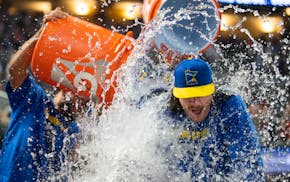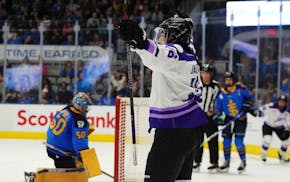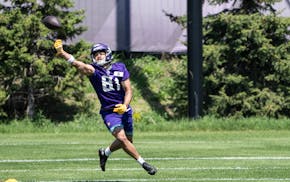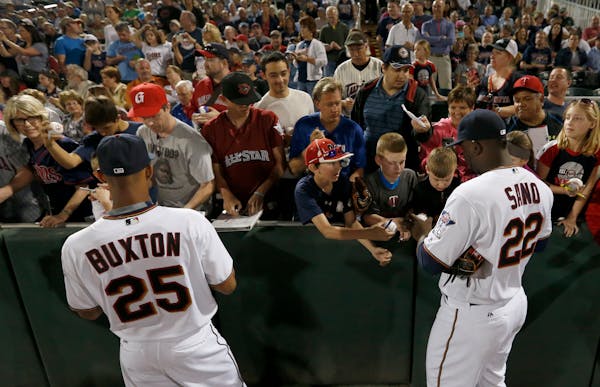They're finally here.
Byron Buxton and Miguel Sano, synonymous with "insanely bright Twins future" for the past four summers, are in the major leagues and in the Twins lineup as the 2016 season opens Monday. For Twins fans, the journey from signee to prospect to big-leaguer has been a little like watching the alarm clock all night on Christmas Eve, the wait excruciating, the fantasy tantalizing — and all the more so because Eddie Rosario is also in the lineup and Jose Berrios, Max Kepler and Nick Burdi are on the cusp.
For Twins fans, or perhaps their parents, this should all seem familiar, and a little cautionary. It's been a little more than three decades since another ballyhooed class of rookies and high draft picks arrived in Minnesota en masse, none of them older than 23 but all of them intent upon winning a World Series. And Frank Viola, Kent Hrbek, Gary Gaetti and Tom Brunansky accomplished their hallowed goal, delivering the Twin Cities' first baseball championship — in 1987.
In other words, as talented as that class of youngsters was, it took five years to win a commissioner's trophy. Their record during that rookie season? The worst in Twins history: 60-102, their only triple-digit-loss season ever.
Want a more recent example? The world champion Royals were built around a core group of position players, including Alex Gordon, Salvador Perez, Mike Moustakas and Eric Hosmer, a cluster of talent long projected to hold postseason parades. They did, in 2015, after losing in the World Series the year before. But all were in place, and losing more than they won, in 2011.
Yes, the advent of young players is thrilling. But young players, in general, don't win right away.
The fragile promise
Miguel Sano pulled on a T-shirt to wear under his jersey recently as he considered what's in store for himself and the Twins in 2016. He exhibited more uncertainty about his wardrobe choice — is it warm enough for sleeveless? — than about his first full season in Minnesota.
"We're going to win games. Our lineup can score a lot. Many more runs," Sano said, looking around the clubhouse and nodding at his fellow outfielders Rosario and Buxton. "I'm here, Rosie [is] here, Buck [is] here. … We're young, but we'll hit."
He makes it sound so easy, so preordained. Sano hit 18 home runs in half a season last year; what's his expectation for 2016?
"Many more," he said simply. "If they pitch to me, many more."
Minnesotans have been captivated by the prophesied exploits of their young-but-inevitable superstars for years. Sano hit almost mythical home runs since signing in 2009, while Buxton was a wizard in the outfield and on the basepaths while still a teenager. Jose Berrios has twice started the Futures Game and last year led all minor leaguers in strikeouts. Rosario arrived and immediately began hitting triples and throwing out baserunners.
Suddenly, projections are turning into progress in Minnesota. And it's becoming difficult to tame expectations.
"There's something about a hot prospect that gets people excited," Twins President Dave St. Peter said. "It's [fun] to wonder, 'Is this the guy?' It's like the lottery — you dream of hitting it big. And on rare occasions, he turns out to be Kirby Puckett."
Or Carlos Correa or Kris Bryant. Making the future even more irresistible is the success of a couple of other teams that retooled around young talent: the Astros, who blossomed, with Correa anchoring the infield, into a playoff team just one year after a 92-loss season, and the Cubs, with Bryant clubbing 26 homers, reaching the National League Championship Series.
Yet the executives who put this team together remain loath to join in any premature giddiness about a still-just-hypothetical resurgence. They understand too well how fragile the promise of youth can be.
"You never know. I say it over and over — you never know," said Mike Radcliff, whose constant focus as vice president for player personnel is on finding, evaluating and securing future Twins. "We're talking about human beings, and they're all different. They're very young, teenagers when we sign them. They're playing a difficult game, at the highest level on Earth. Everybody wants guarantees, and we work hard to find the best talent. But no matter what you think you know, it's all just projections — wishful thinking, really — until they actually do it."
Sano himself is a victim of the game's volatility. He worked hard on his defense before the 2014 season, taking hours of fielding practice at third base before training camp. Eventually, he noticed a pain in his right elbow that grew so bad, he was told to rest it. When he got to training camp, a torn ligament was discovered, and surgery to fix it cost him the entire season.
Rosario has a habit of swinging at pitches out of the strike zone that many scouts believe will prevent him from being a valuable contributor in the long term. Berrios still has enough difficulty controlling his fastball, the Twins decided another few months in the minors are in order.
Buxton has had his career interrupted by injury, including a scary collision in the outfield that knocked him unconscious. And when he arrived for his long-awaited debut last June, he had only a modest impact, shoring up the defense but mostly showing only glimpses of his raw skills.
No wonder GM Terry Ryan refuses to put any expectations on Buxton's narrow shoulders.
"Young kids, you never know which way they're going to go," Ryan said. If people have doubts about Buxton, "it's fair. He doesn't have a résumé. I don't get carried way [because] you're always wondering which way they're going to go."
What's it mean to be No. 1?
But why should anyone wonder? Buxton is part of an exclusive confederacy: The best of the best, the surest of sure things. To be rated the No. 1 prospect in all of minor league baseball is to be guaranteed a long, successful major league career, and perhaps someday, an even bigger honor: immortality, as bestowed by the National Baseball Hall of Fame.
Except, as it turns out, there's no such thing as "guaranteed" in baseball.
Baseball America magazine, with the consultation of dozens of baseball scouts, managers, coaches and executives, has anointed an overall No. 1 prospect for more than a quarter-century; in that time, three players with that extraordinary credential have worn Twins uniforms. One is Joe Mauer, a two-time honoree, who lived up to that billing by going on to a career that has spanned more than a dozen seasons, three batting titles, an MVP award and six All-Star Games. Another is Buxton, the elite of 2014, whose Twins career has barely begun.
And the third? Consider him a cautionary tale. Delmon Young wasn't a Twins draftee, but the Twins acquired the outfielder in a trade only 192 games into his major league career, his promise still intact, his career still embryonic.
"We think his power is going to continue to improve," then-General Manager Bill Smith said after acquiring the 21-year-old Young from the Rays in November 2007, "and he will be a middle-of-the-order difference-maker in our lineup."
But Young, runner-up for AL Rookie of the Year in Tampa Bay, never flourished with the Twins, posting only one season of his four in Minnesota that wasn't a disappointment. Advanced analytics rated him as one of the worst-fielding outfielders in the game, and his offense, save a 21-homer season in 2010, rarely made up for it. The Twins dumped Young in a trade-deadline deal in 2011; at the age of 30, he is currently out of baseball.
Winning is a process
Paul Molitor was only 21, with just one season of Class A ball behind him, when he was handed the leadoff spot in the Brewers lineup in 1978. The future Hall of Famer learned quickly and delighted his old-school manager, George Bamberger, by batting .273 as a rookie and finishing runner-up in Rookie of the Year voting.
Only one problem.
"I didn't understand the game," Molitor said. "I could play, I could get by at a certain level, but I had no idea about what it takes to win. It took me years to figure out the nuances and the sacrifices that winning requires."
Now that he's a manager himself, Molitor is trying to remind himself that his players lack that knowledge, too.
"Anytime you're using a fairly high number of inexperienced people up here, you have to understand patience is going to be required, teaching is still going to be required," he said. "You try to introduce the concept of winning, but they're going to have to figure out how to balance getting comfortable up here and understanding what our goal is collectively and how to get there."
Tom Kelly walked that fine line, too. The former Twins manager, who won a pair of World Series in his first five full seasons on the job, endured eight straight seasons of losing baseball in the 1990s before a more talented group of young players began assembling in the Metrodome.
Corey Koskie, A.J. Pierzynski, Torii Hunter, Doug Mientkiewicz, Cristian Guzman, Jacque Jones — "They grew up together, and they became men together," Kelly said. "One would come along, and you'd say, 'Let's see what you've got.' And another, and another. It takes a while, but they started moving forward, and the more they got to playing, the more they got it."
In 1998, the Twins went 70-92, and did it with six players in the lineup who were 29 or older. By 2001, no regular was even 30 years old — and the team challenged for a division title until mid-September, winning 85 games.
"If Guzman didn't get hurt at the All-Star Game, we might have hung in there," Kelly said. "A lot of runs went down the drain with Guzzie."
That group went on to win division titles in four of the next five seasons. But Kelly also knows that young players can mislead you, too. Danny Santana was a real find as a 23-year-old rookie in 2014, batting .319 and collecting 41 extra-base hits.
"I'll be perfectly honest, I thought we were all set, I really did. I thought he would end up being one of the better players in the league, let alone the team," Kelly said.
But Santana couldn't repeat the success last year, losing more than 100 points off his batting average and dropping to 15 extra-base hits.
"We got slapped in the face. What a surprise," Kelly said. "I always said over the years, 'Let's see you do it for two or three years.' And sometimes, they can't."
Waiting 'to find out'
So what's it going to be in 2016? Are the Twins headed to the postseason, on the cusp of launching themselves toward the top of the league again? Or is the arrival of the long-hyped youngsters merely an interim step in a much longer process?
"Having the talent and learning how to use it, how to refine it into the type of skill that wins baseball games, those are two different propositions," Molitor said, adding that early in his career he "just played [while relying on] the physical side, but the mental part came later."
That said, Molitor's sheer talent contributed plenty to a Brewers team that posted a winning record in each of his first six seasons.
Perhaps Buxton and Sano will lead that sort of rejuvenation, too. Maybe Rosario and Berrios will become All-Stars, possibly Kepler and Byung Ho Park will turbocharge the lineup, and it's conceivable some of the young relievers in the system will help form a Royals-quality bullpen.
"That's the plan," said Radcliff, who had a hand in building this next-generation Twins team. "I'm as excited as anyone to find out."

Paddack clings to perfection into the sixth inning, pitching the Twins past the Giants
Reusse: Twins play Giants, triggering Mays memories and a question: Can we get the Black players back?

Frost turn away Toronto, even PWHL playoff series at a win apiece

Montigo Moss, working to make the Vikings roster, provides an update on famous father Randy

